The scale of these 'renewable' intermittent electricity generation projects is daunting, and federal Energy Minister Chris Bowen won't even say how much it's going to cost.
TRANSCRIPT:
(This transcript is derived from an automated process. The video recording is authoritative.)
Okay, before I start off, just very quickly about who is Property Rights Australia and what we are. So we're a grassroots community organisation. We don't get any funding from anyone except our members. Okay. I better use this. So we don't get any funding from our members, sorry, only from our members, not from oil companies or coal companies. So really we're about protecting people's property rights. So I always say this at the start of my presentations that whether you own a home suburban home or a broad acre farm, PRA believes that everyone are entitled to the basic rights of exclusive access use and the opportunity to make a profit.
I want to talk to you about what's happening around Australia now and what's happening around the world, and that's the green energy transition. And what comes from that is the reckless rollout of renewables and just a little bit about the framework of how that's come to be and I guess the overarching international frameworks and how Australia has responded to that. And so we've got the 1994, I guess, convention on climate change that really set up the first structure to stabilise our greenhouse gas, I guess concentrations. And then we've had to coyo protocol that was produced in 1997 but was only really operationalized in 2005. And that's when John Howard worked with a number of state premiers like my mate, Peter Beatty, and they developed the Vegetation Management Act that took large chunks of, I guess land off private property owners so they could meet that protocol.
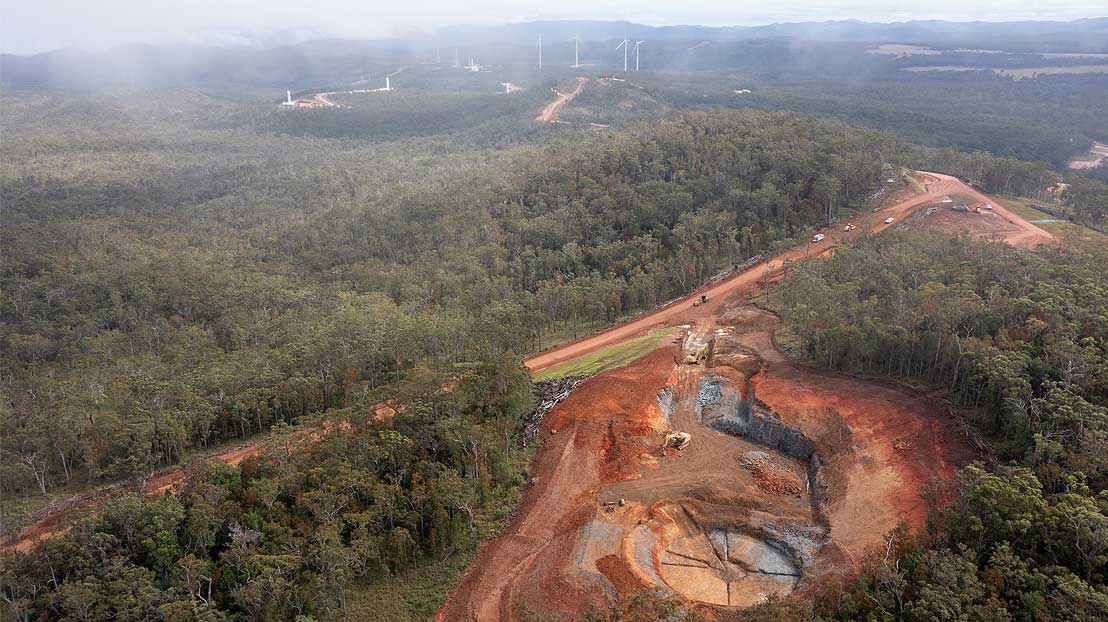
And now quite recently we've had the 2016 Paris Climate Change Agreement, which really sets about some national determined contributions. And where that ends up is those NDCs, that's where you get the 43% by 2015 levels to meet by 2030. So 43% decrease in emissions by 2030 and a hundred percent by 2050. And that's how really Albo talks about the target. It's now a target of how much electricity is going to be generated into the national energy market. When I talk about the national energy market, it takes in Tasmania, south Australia, new South Wales, Victoria and Queensland. It doesn't include Western Australia. And so that's the national energy market and they've developed a number of policy frameworks to help that roll out. And it's things like rewiring the nation where they're giving 20 billion to help investment into building all these new transmission lines. And there's other things like, sorry, the capacity investment scheme, I don't know if you've heard about it recently.
We dunno how much money it's costing us. Bowen won't tell us, but it's when a company like they put out a bid to produce a certain industrial solar and wind projects and they're guaranteed a base income of that. So a base profit and if it falls, so if it falls below the baseline and at the baseline we pay them, if it goes above it and they make a bit of profit, they pay us. So yeah, and also the National Energy Transformation Partnership. So that's how we get a, it's like all the state energy and climate change. Ministers come together with bone and they work through a number of projects with working groups. How are they're going to get this transmission supposedly make it reliable, stuff like that. So that's a bit about the policy framework. And then we've got this thing that's been around for a little while now called the safeguard mechanisms, and it's about reducing the emissions of 215 major emitters.
And a lot of them are in Queensland, whether they're aluminium smelters or whether they're the big concrete, the cement works that make cement powder at Gladstone uses a lot of energy. And so all these high emitters under this safeguard mechanism, they started off at the baseline and they've got to reduce that baseline of emissions each year. It's roughly around 4.9% of their baseline by legislation by the year 2030. And that's driving a lot of these high emitters overseas and it's driving our manufacturing overseas. The ones that stay though, they can offset that part of our offsetting that is they can buy these credits from renewable energy projects and you see, so it's about buying that renewable power that's generated and they can use that to offset for their power, but they can also offset their emissions by buying carbon offsets. And that's where you get properties like around Charleville that are full of the mulga or there is a lot of properties bought for carbon offsets by large corporations. There's a road between Thargomindah and Quilpie talking to am mayor out there recently. And there used to be 18 families living along this road and now there's no families living along this road. It has all been bought up for carbon offsets. So there's no one living on these properties, there's no maintenance, there's no food being produced. So that's some of the impacts as well.
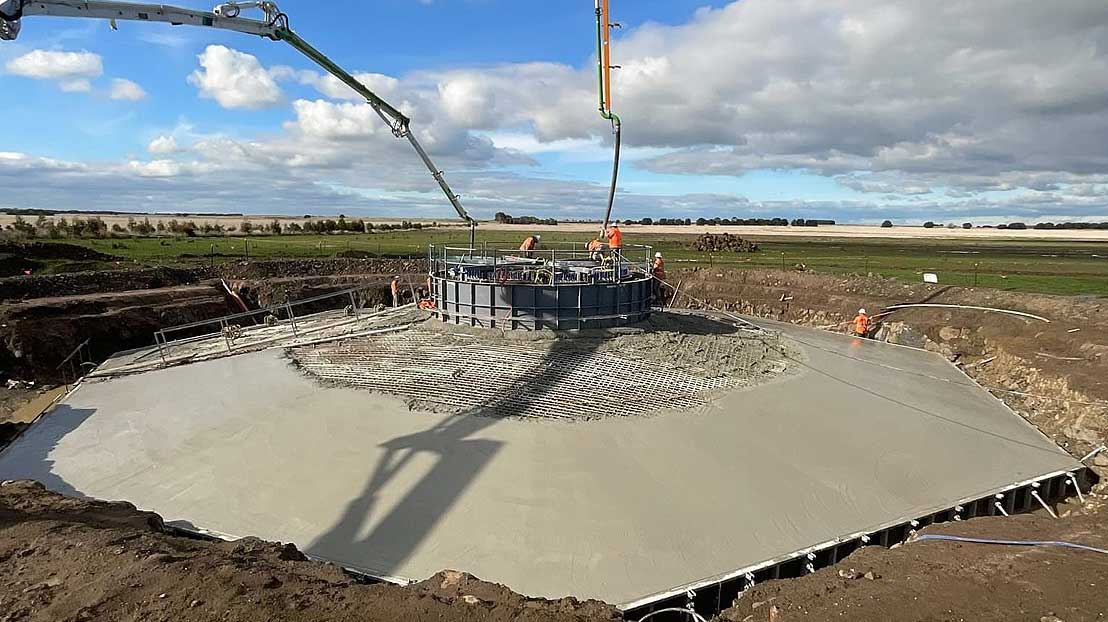
All this is wrapped up in Albanese most, I guess, modelled piece of planning done by any opposition in history. And that's what he was promoting in the launch when he got into government, this integrated system plan, which comes out in every two years and it's just been presented as a draft to 2024. The last one was a 2022. So it's like a roadmap. How is Albanese going to get to a hundred percent renewables by 2050 in our electricity grid? And it's made up of a, they call it the optimal development pathway. So in a nutshell it's a hundred percent renewables and that's going to be linked through heap, small transmission lines backed up with firming power, which I'll briefly define and then backed up with turning power. And then again, any gaps I'll make up with these things called peakers, gas peakers, which will eventually be made to run on green hydrogen, the green dream.
But you can search that out on the aim, if you punch that into Google, it'll come up.
So the scale and rate of change. So some people here might've heard this definition, but they call renewables variable renewable energy because when the sun doesn't shine and the wind doesn't blow, you don't get any energy yet. So you get these peaks up and down and it's those troughs where modern human societies need energy, like we need oxygen, but renewables produce energy like a rain on a dry land crop. Sometimes you get summed, sometimes you get too much, sometimes you don't get any, and that's the problem with renewables. But we're running headlong into this a hundred percent renewable target faster than most other countries in the world. And it is the new gold rust. But unfortunately we are being deceived because it is fool's gold.
So what's it going to look like?
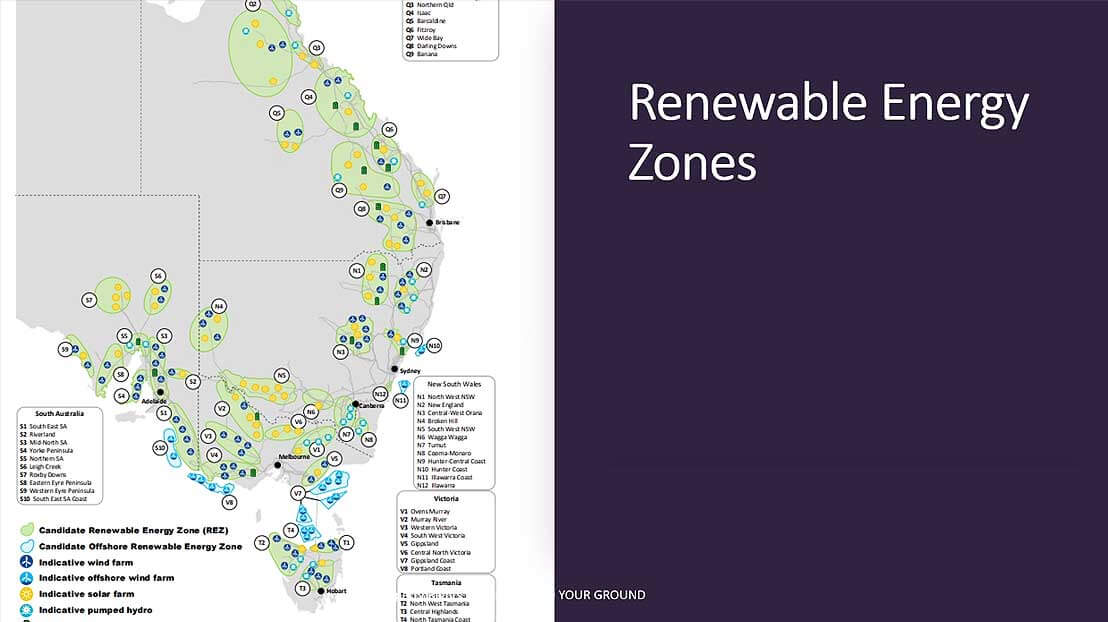
This energy grid, we're going to have large scale wind complexes. And when I say capacity factor, that's theory of what they say these big complexes can produce. And then I want to talk to you briefly about reality. So let's say for a big wind factory is produces a hundred megawatts. That's what they say on the name plane. Oh, it's going to be beautiful, it's going to power so many thousands of houses. But then you've got the reality, the capacity factor when the wind doesn't blow. And remember with wind turbines, if the wind blows too hard, they switch 'em off too low, switch 'em off, the wind needs the sweet spot is six metres a second. Okay? So with a 30% capacity factor, you only get, say if it produces a hundred megawatts, it's only 30 megawatts and that's where they need to overbuild so much. And the same with solar. Its capacity factor is 25%. So you've got quad triple that offshore wind is about 50 to 55%. Emerald wind farm at the back of Cairns, been there for 20 years. Its capacity factor is 18%. Germany recently came out of what they call a renewable drought and it's mentioned in the integrated system plan by emo, they've come out of a renewable drought of 38 days when the wind turbines didn't work.
That's why they're going back to coal. We're blowing our coal stations up and we're going to have distributed powers, rooftop and batteries and electric vehicles. So in this plan, the optimal development plan, it's the rooftop solar, the wall battery, there's subsidies coming out now they're promoting them and your electric vehicles, they did estimate Australian population was going to get to 89% electric vehicles by 2030. Guess what, even the department's own modelling now says, oh, it's about 26%, but they'll be taking power from your electric vehicle and your wall battery as a firmer to make up those gaps.
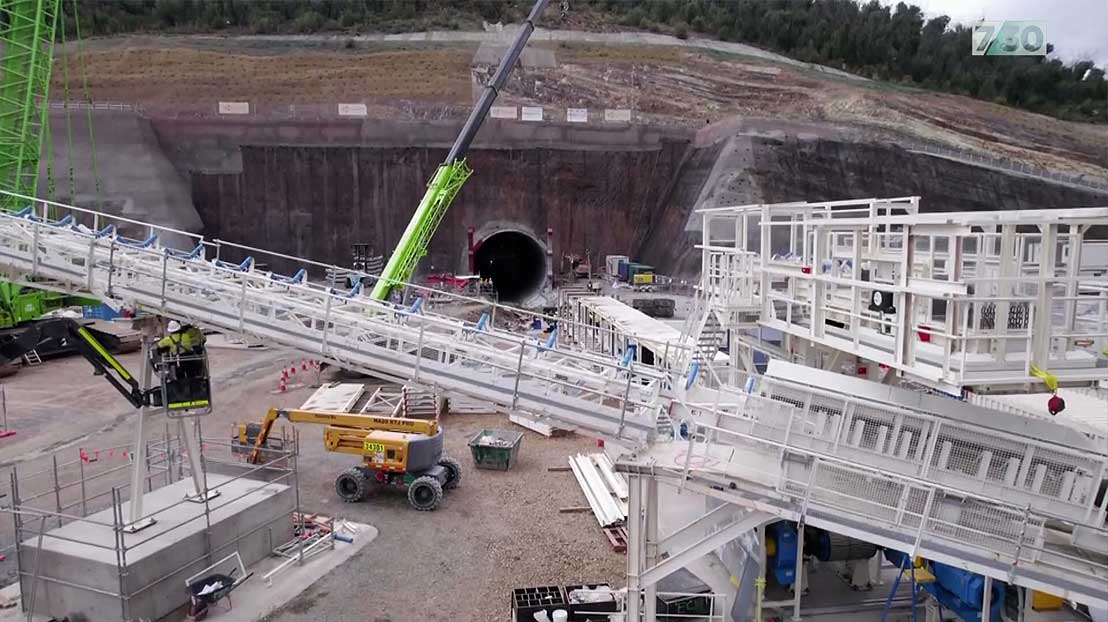
Firming capacity, it's about pumped hydro. So there's one going up at Gympie, apparently hope it doesn't. And there's the big Snowy 2.0 if it ever gets finished. So without those two, the whole system would collapse. So they're pushing us to the edge of an energy cliff because all our cold fire power stations will exit the grid by 2038. Even a emo, the Australian energy marketing operator says, whoa, we've got to, this is a big risk. And not only are they going to exit the grid, they like blowing them up. So there's no way we can restart them. It's like some internal terrorism, what are we doing?
Large scale utility batteries. I went to a meeting in Rosewood the other night and there was a hundred, 120 people there and they just found out that proposals for a large battery and there could be up to 540 foot containers placed into a rural area with a couple hundred thousand solar panels put onto it. And they're called battery energy supply systems and they're popping up all around Queensland, around Australia and they last two to four hours. The modelling that email has done once they have the whole thing a hundred percent electrified is they estimate with Queensland being online full of renewables and the rest of the states, something bad happens. Like what happened in Victoria the other day when you lost six of those big transmission towers, they fell over and say there's multiples of that, that the whole system will last eight days. They reckon they've got enough power with eight days, there'll be a lot of manufacturing closed down, but that's with Queensland being fully online still operating, boom-boom-boom.
So it just goes to show and we're going to have gas fired peak. Its replaced with green hydrogen. Now, high voltage transmission line, this is like the transmission structure straight out of the integrated system plan. And you can see from the top of Australia right down undersea line to Tasmania, you can see it's all going to be linked two way pushes. Power out pulls power in and it's all connected to these things here. That's where one pumped hydro system is. And Sydney be another one down here somewhere. So this is where they're going to be relying on those big pumped hydros for firming power, but they dunno exactly how many kilometres of high voltage transmission lines are going to be. Remember this stuff is expensive, it's going to be between 10,020 6,000 kilometres. And remember the rest of the world is also building transmission lines, a lot of them that are sold on the stream.
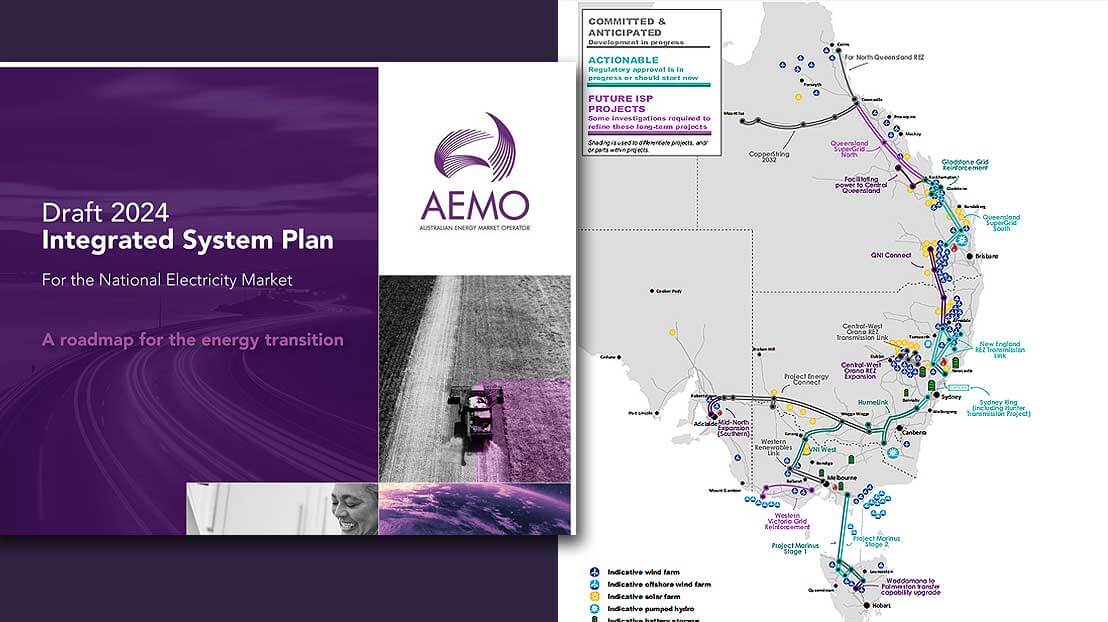
And so there's supply strain constraints, labour constraints. We're directly importing transmission line material straight from India. And it's even being put up from with people from India work teams because we haven't got enough work teams here. And these are another things called renewable energy zones. So there's 47 of them around Australia, you can see the ones in Queensland there. And they're just geographic areas where they've picked, which are going to be built out with these renewable energy, industrial, solar and wind complexes with batteries and transmission lines. Now each one of those renewable energy zones has like a target where they've got to produce enough energy to feed into the optimal development plan. And really some of those areas are going to be built that you won't, and that is why they're saying the geographic footprint is saying, look here down in Victoria where they say, and Richard mentioned before, up to 70% of land's going to be covered in solar panels, wind turbines, batteries and transmission lines. Imagine the impact of that. The IPA has recently put out a paper where they've done modelling as well, an estimation it's going to be between 56 million hectares and up to 181 million hectares depending on the scenario which goes how many hectares.
So they've got scenarios what they think, how they're going to get to this, a hundred percent renewables. The first one's a step change scenario. So imagine in the next three decades we're going to triple industrial scale renewable this decade, okay, 20 20, 23, we're going to have triple the amount that we had and then we're going to double that again and then double that again because remember the overbuild that's required for renewables with the capacity factor. So they think that's most likely and that's what's on track. Then they've got this other scenario, which is the green energy export scenario where they think, and you've heard Bowen and Reni, and I won't mention the carpet bagger that's with them, but I mean they're going to start producing hydrogen out of and exporting it out of the port of Gladstone and they're going to export it to, they've already got contracts in place with Germany, Japan for a source of power.
So that's 34 times the amount of geographic footprint for wind and solar than we have now. So that, and I'll show you a map of what that means, how much, it's a lot more than what we've said. So this is back to the step change scenario, if you remember the triple, double double in the next three decades. So this one here is where we are now. So the green is wind and the yellow is solar. That's next decade and that's the decade after. So that's where they want to be. So that's what they think is most likely. But Queensland and a few other states, they want to go to the hydrogen export. That's what they want to do. So hydrogen takes a lot of energy to break down and separate the hydrogen from water and they use that with the electrolyzers. That is the, even though it's called the hydrogen superpower, there is actually the export green export. So here we've got now next decade, look where we are here with Queensland. So we are talking massive areas of our landscape that are going to be covered up in this stuff. Have you seen any maps that the state's put out about the geographic footprint At the moment you haven't seen anything, have you?
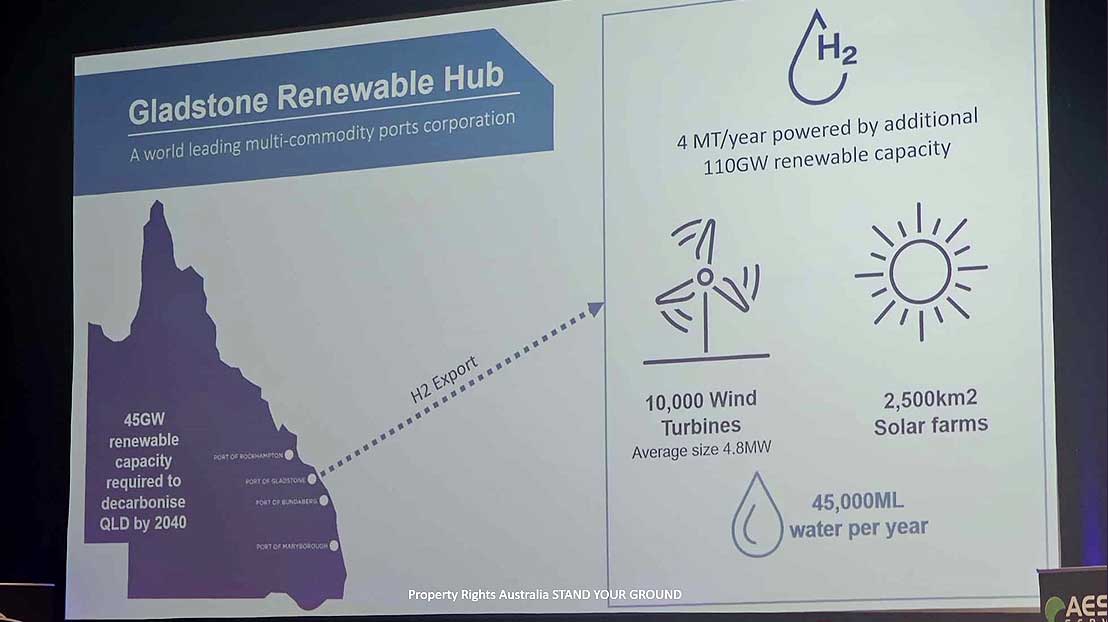
And this is a slide taken from a presentation that was provided by the CEO of the Gladstone Port Authority recently out an engineering forum forum. And they were saying he was spruiking, we're going to export hydrogen out of the port of Gladstone, but to do that we're going to need 45,000 megaliters of water. But we're also going to, because it takes a lot of power, like I said, 10,000 wind turbines and that's just in behind Gladstone in that renewable energy zone. And guess what? Plus two and a half thousand kilometres of solar panels, 630,000 acres, around 250,000 hectares in one area. And believe me, it's already happening. And you think, oh Jim, mate, I don't think that's right. Well, England is just an out the uk. They're going to build 18,000 wind turbines between now and 2030.
So the spatial footprint, now Steve Naski has given me this map. He's a gem. So this is just what's happening now because you've got a lot of development from Gladstone ride up these coastal ranges out to the back of Cairns down around the wide Bay area and out through the darling downs, even now in Brisbane, because remember in the small print of Renis renewable energy rollout and the rollout of renewable energy zones, there's a small print out where they can have further renewable development outside these renewable energy zones to make up the power. So don't think, oh geez, I'm lucky I don't live in one of those zones because they'll build 'em wherever they have to. So that just shows you, it's a bit hard to see, but you can see all next to these national parks here on the top of these ridges are wind developments.
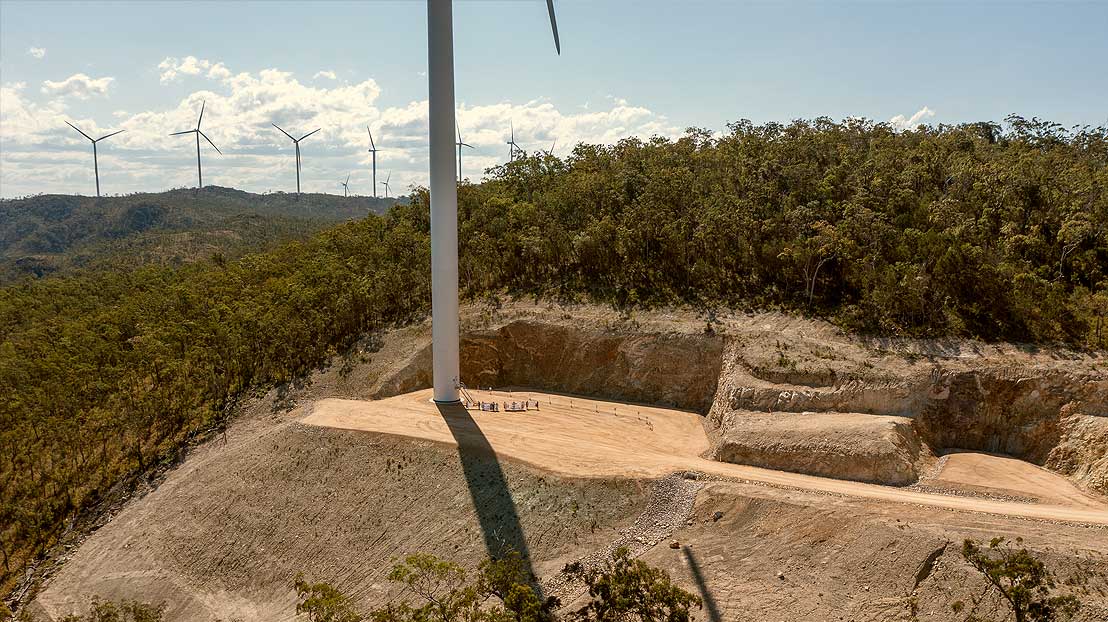
And that is where like Richard mentioned before, they're blowing the tops off these mountain ridges, pushing these big tracks up that are 85 metres wide. And I'm talking these steep ranges, they've never been cleared with agriculture because it's too hard to clear. They're right up the top of these mount. These is the last bastion where all these precious flora and fauna are surviving in some of the work instructions for the companies building these big wind developments. There's actually a steam ACOs is actually seen koalas taking photos of them in the bush that it's going to be cleared the next day. They're actually given instructions to actually euthanize euthanizes. And you might've seen this in the media koalas by carrying a steel rod or crowbar and a pit to the back of the head. Now you imagine if I did that as a farmer, I'll be in jail. And where are the greens? You know where they are? All I hear is crickets. They're supporting this.
So the spatial footprint, that's actually a, there's more than a thousand projects at a national scale now. There is nearly 1400 and remember this is going to be tripling this decade doubling after that and doubling after that. It's going to destabilise our agricultural productivity fractured division and at our regional communities fires environmental impacts. So 200,000 hectares are going to be affected just with the projects we've got now in 46,000 kilometres a road. And it's a very unbalanced regulatory environment and the interrelationship of all these things.
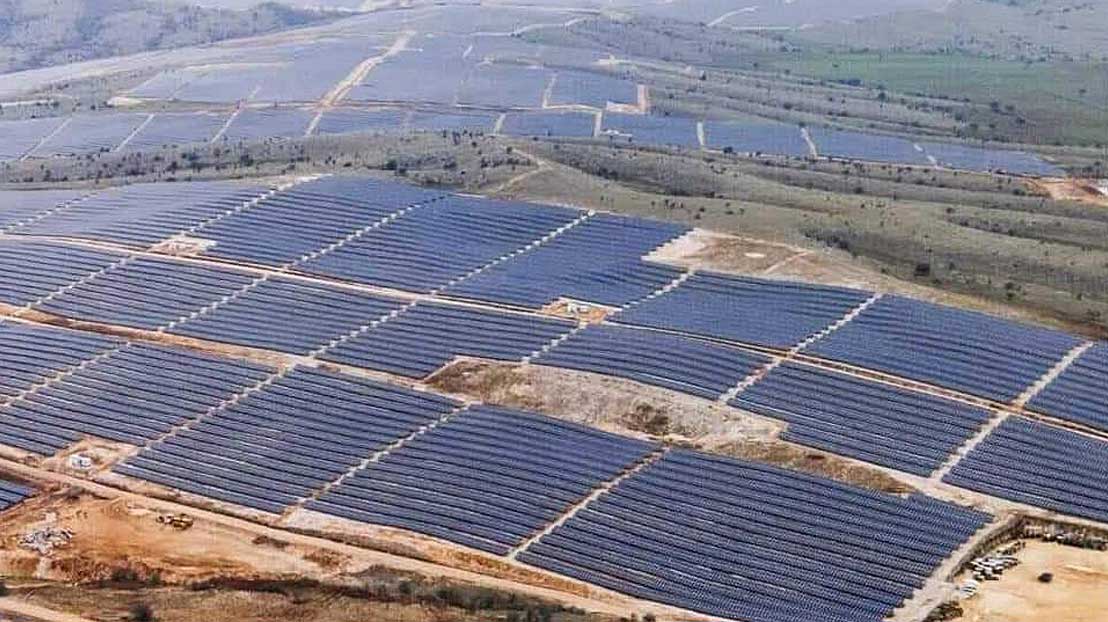
Here's a picture of insurance issue, the insurance issues. If you live next to a big solar farm or factory and wind development, what happens if you are cocky, like cocky, do light a few fires, get the permits, but they burn out the next door neighbour. It's a big wind factory and I've only got $20 million public liability, but the factory's worth 750 million people can't get insurance to cover themselves and these people down south can't either.
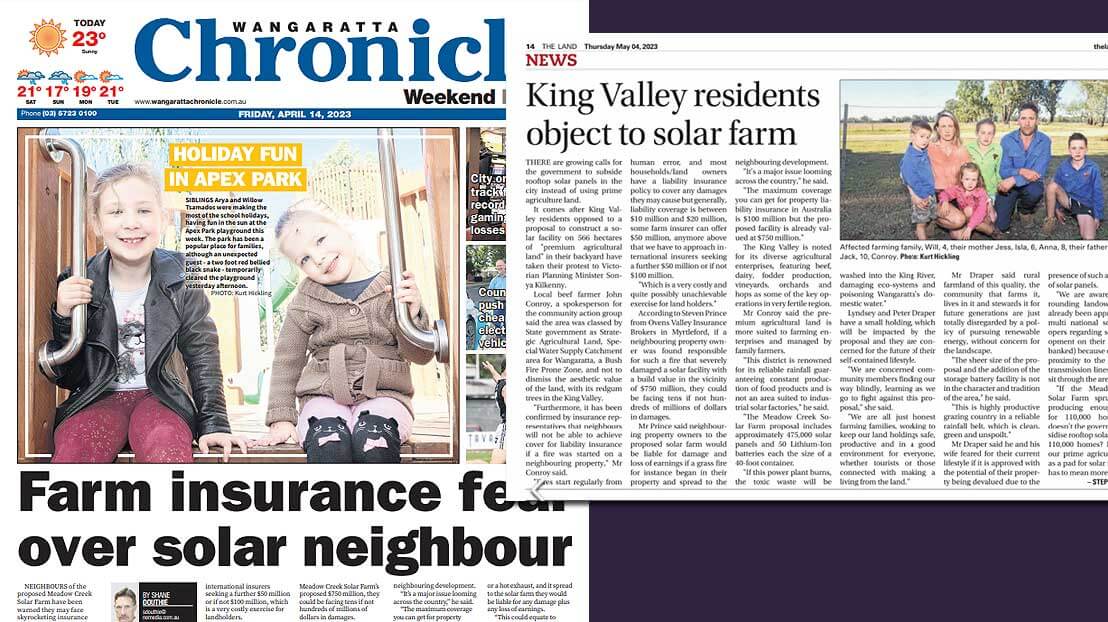
Now solar panels burn and so do the big lithium batteries next to them. That's a picture of one that's recently burned in South Australia.
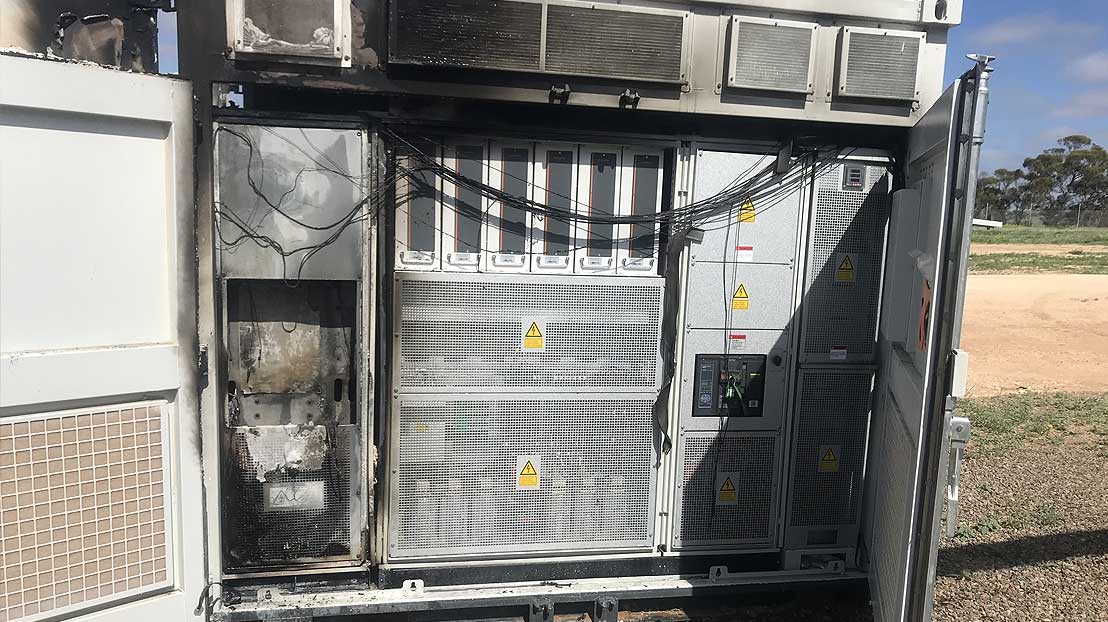
There was another one in Boulder cone just near Rockhampton. That's a picture of Greece. Do we want the landscape of Australia to look like that in the years to come? And guess what? In fact, these panels are all made in China. So they're loving it, they're loving it. We are giving our energy sovereignty to a foreign power and China doesn't exactly love us. As soon as we did the, I guess the rally down in Canberra on the sixth it came out, the greens came out that, well, agriculture really needs renewables to survive and you can run sheep under these things. Look, and they do well and they forgot to mention all the cables running under here. How are you going to rejuvenate the pasture?
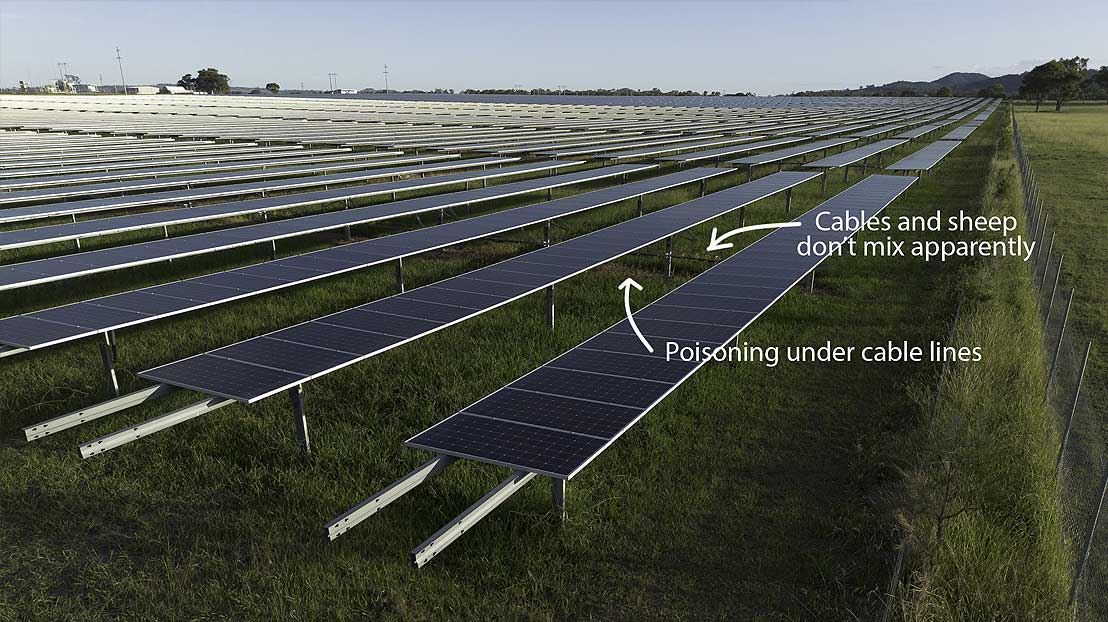
How you're going to fertilise the pasture? How are you're going to put watering points in there? How are you going to undertake cell grazing? But you can see how they've got a bit scared. There's a wind turbine that caught on fire. It happens about one in every 300. Very hard to put out because remember they're 300 metres tall and these are some of the turbines. That's the 300 metres at the tip. And this is some of the, look at some of the clearing here that's done up in the top of ridges. And that is happening not just in Queensland but all around Australia. There's some of the big bases that they're doing. There's a thousand cubes of concrete into each base. There's one being developed there, a thousand cubes. And it's all about lowering emissions, isn't it? If you know anything about concrete manufacturing, you know how much emissions in it, that's the size. Look at the quarrying that they're doing. And remember under the reef legislation, I can't have a bear area on my property being a beef farm bigger than a kitchen table or I can get a knock on the police, knock on the door by the reef police where these guys seem to be able to do what they want.
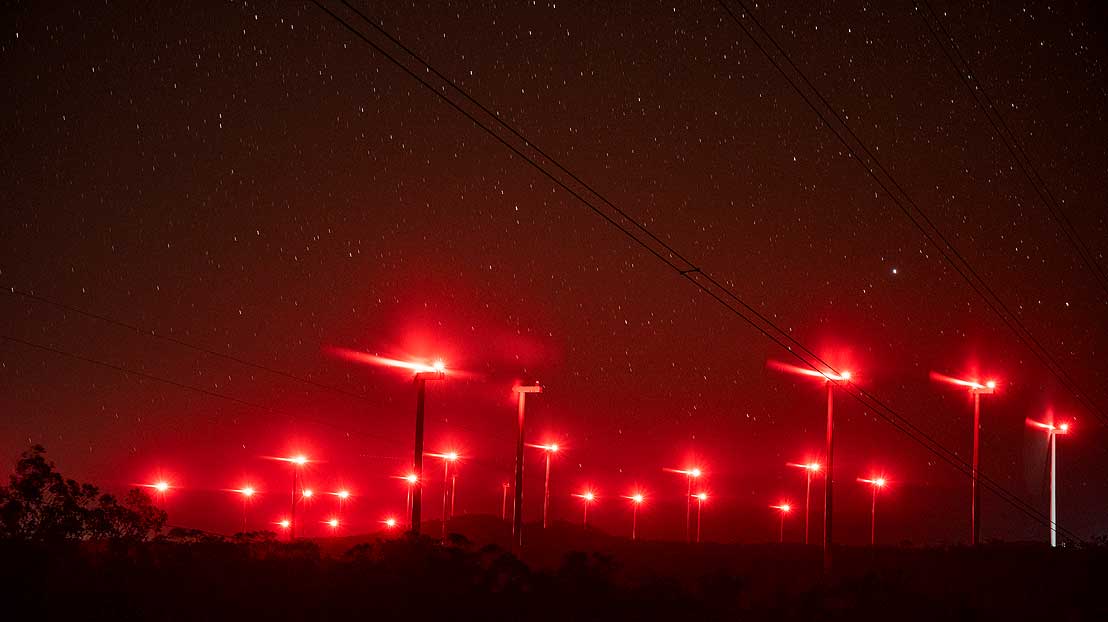
There's a scale of the new invasive species, these things. And then you've got the lights because they're so tall. There's people living at Kaban, this is this one example, 70 K southwest of Perth, sorry Cairns, that line their beds at night. And when they look up at the ceiling, they also see as blood red because of these lights. Then there's the noise that's up at Kaban.
Then there's all the animals are up on top of these ridges that are getting smashed up, chewed up. This is how we've responded. We've recently done a, carried out a big rally in the front of Parliament House down at Canberra and we had a good rollup, the greens and all that said, we had about a hundred people there, but there was nearly 3000 people there. And they were said we were paid off by the big coal and oil producers, but we all obviously made our own way down there. And that's just a few pictures. And then we had some really good meetings with the opposition and we worked out some strategies going forward. So really what we want is to just pause. We're not going to boil to death overnight. We want secure energy because energy security is national security. We don't want to live in energy poverty in Australia. We want our manufacturing to stay here and we don't want energy rationing. And that's what we will get under a hundred percent renewables.
So we need a federal Senate inquiry because that's going to bring all this to the floor. So I encourage you, especially being the year of elections, I even ask your local councils what their position is. Do they agree with this intent, this policy? Now your state government candidates and your federal government candidates, because guess who's knocking back the Senate inquiry for the six times? People like Pocot and a number of green and labour senators. Why? What have they got to hide? I've just shown you what they've got to hide, support action groups. And this is a year of elections.
So my last message to finish off is to stand our ground. Don't give into this step away from mainstream and be brave and bold because this must be stopped. Not for us, well obviously for us, but for future generations because we are going to be energy poor energy poverty. We're going to wreck our environment, our food production system, and guess what? It's going to all contribute to the increasing cost of living, which we're all suffering now. It's going to get worse. It's never going to go down. They're never going to provide $270, $75 in power savings. They're going to keep on flicking some rebates out you. But there's only one way - it's going up.
Every country in the world that has tried to go a hundred percent renewables has failed and we will fail. There's alternatives. So thank you very much.






